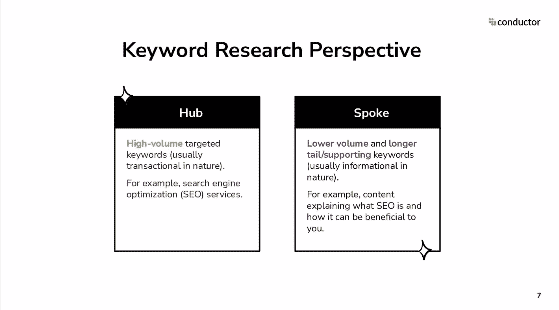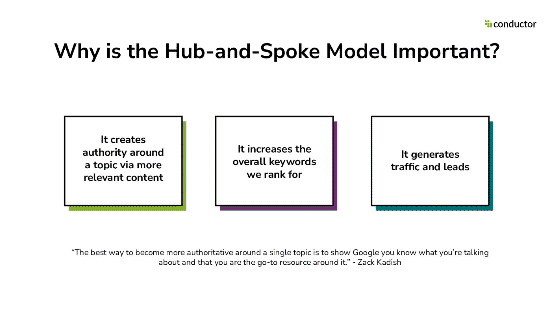“When we think about creating topical – evergreen, informational content – it’s sometimes hard to fit all that information on one landing page,” said Zack Kadish, SEO customer success team manager at Conductor, in a recent webinar. “So, we when think about ‘hub-and-spoke models,’ we want to think about generating content on a broad topic while diving deeper into more relevant areas on different parts of the website.”
“This can help increase organic traffic and keywords rankings, and even lead to more downstream metrics such as conversions, leads, and sales,” he added.
Similar to pillar page structures, hub-and-spoke models are designed to establish a site’s authority on the ins and outs of a given topic. But, how do they differ from other content marketing models?
What is hub-and-spoke content marketing?
“Think of the hub as the center of the wheel, and all of the spokes pointing outward,” Kadish said. “In an SEO and digital marketing lens, the hub is the main topic that we want to create more authority around. The spokes are all that supporting content that might help boost authority around that topic.”
Kadish said marketers can identify potential hub-and-spoke topics through keyword research. The higher volume, more transactional keywords are likely to be “hubs,” and the lower volume, long-tail keywords will serve best as “spokes.”

Chaz Marshall, SEO success manager at Conductor, gave a helpful example of a hub-and-spoke strategy in the same presentation:
“Let’s say civil engineering is the hub topic. If someone is researching that career path, a great subtopic to feature would be, ‘What is the average salary of a civil engineer?’ That would be a spoke.
“Each of those topics trails back to your brand, so, why not help Google and people who have never heard of your business notice that you are industry experts?” Marshall added.
Why is hub-and-spoke important for marketers?
“I used to think it was impossible to compete on the web if you weren’t a major domain,” Marshall said. “But, as an SEO, my job was to experiment.”

He pointed to a personal example: his family’s ice cream shop. Their content hub was centered around a specific fruit flavor: soursop. So they identified surrounding content (adjacent subjects that they knew people were interested in through trends and keyword research). These pieces on soursop flavors became their spoke topics.
After publishing these hub-and-spoke pieces, Marshall’s family began to see how far-reaching their content marketing efforts could take their brand. They were drawing in users to their site through that popular hub topic and then funneling intrigued readers down the marketing pipeline via spoke pieces.
Marshall noted that one of their customers originally found them simply by searching for information about soursop fruit. He was curious to know what it tasted like but didn’t have an ice cream shop that offered that flavor near him. So, when he decided to visit the store later that year, he told the staff that he found them through one of the specialized spoke content on their site.
The hub-and-spoke framework, when done well, has the potential to turn visitors into leads, even if they’re not ready to convert when they find your site.
Producing evergreen, educational content helps readers learn something, and, in turn, increases the likelihood that they’ll remember your brand.
“From that day on, we knew that content marketing was where it’s at,” Marshall said.
Watch this webinar presentation at Digital Marketing Depot.
The post How hub-and-spoke content marketing can help improve SEO appeared first on Search Engine Land.
No comments:
Post a Comment